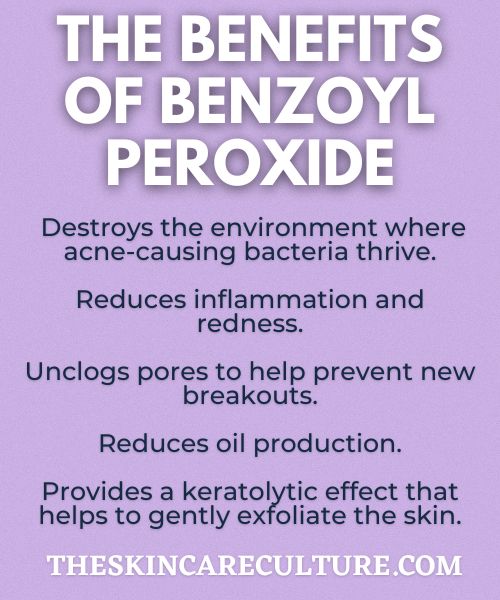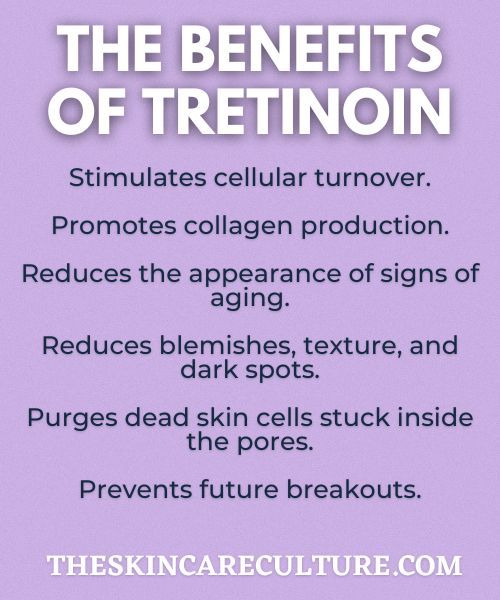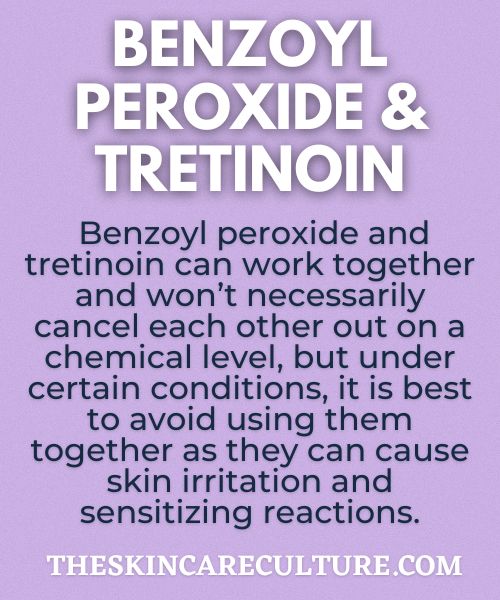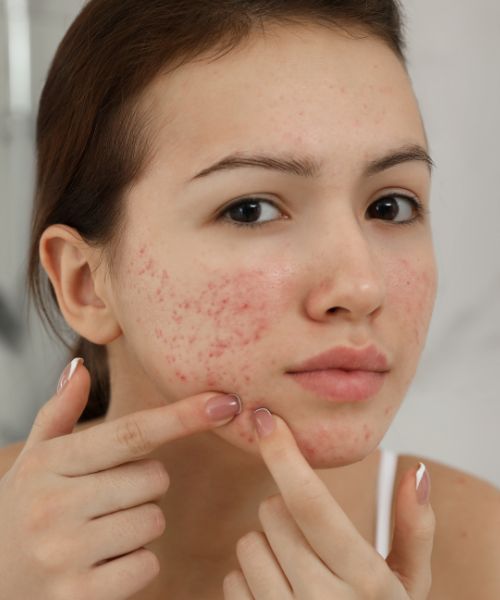Benzoyl peroxide and tretinoin are popular acne treatments that can decrease inflammation, clear the pores of acne-causing debris and bacteria, and reduce the formation of new pimples.
However, there have been some concerns that combining these two treatments can be ineffective because they may interfere with each other and prevent them from working optimally.
While this is a valid concern, it has been proven that benzoyl peroxide and tretinoin don’t cancel each other out but can still be problematic for the skin if used together in certain circumstances.
Therefore, in this article, we will break down both ingredients, discuss their benefits and drawbacks, and explain when and how to use them for the best results.

What is Benzoyl Peroxide?
Benzoyl peroxide is one of the most common ingredients in skincare products designed to combat acne breakouts.
It’s an industrial chemical that belongs to the peroxide family and has been used in medicine for nearly a century.
When it comes to skincare, benzoyl peroxide comes in many forms, and it’s an ingredient often found in cleansers, gels, and creams.
Benzoyl peroxide is a small molecule that travels deeper into the skin and carries oxygen in the pores to destroy the airless environment where acne-causing bacteria thrive.
However, although benzoyl peroxide is a fantastic acne-fighting chemical, it’s best to incorporate it into your routine sparingly and slowly minimize use before eventually stopping it when acne is significantly reduced.
This is how you will give the healthy bacteria a chance to balance itself out and become commensal (neutral) or beneficial for your skin instead of being hostile towards its environment.

The benefits of benzoyl peroxide:
- Destroys the environment where acne-causing bacteria thrive.
- Reduces inflammation and redness.
- Unclogs pores to help prevent new breakouts.
- Reduces oil production.
- Provides a keratolytic effect that helps to gently exfoliate the skin.
What is Tretinoin?
Tretinoin is one of the most researched anti-aging and anti-acne treatments in today’s market.
A powerful form of vitamin A, tretinoin improves cellular turnover, promotes collagen production, and reduces skin imperfections such as blemishes, texture, and dark spots.
It does this by binding to retinoid receptors in the skin and instructing them to do their job in maintaining the skin cells better.
This action normalizes the cell function and influences the cells to behave in a healthier and younger way, making the skin look brighter and more youthful and purging the dead skin cells stuck inside the pores that have contributed to the formation of blackheads, whiteheads, and pimples.
However, while incredibly effective in clearing up clogged pores, tretinoin has a few side effects, including irritation which can leave you with red, sensitive, inflamed, and peeling skin.
Given that tretinoin is a powerful active ingredient on its own, you need to make sure you are not adding fuel to the fire by using skincare products that can potentially exacerbate these known side effects.
When using tretinoin, it is important not to use scrubs, exfoliating acids (especially AHAs), and enzymes, as well as harsh and drying cleansers that can make your skin burn and feel uncomfortable.
It is also a good idea to switch to a heavier and more occlusive moisturizer while using tretinoin and opt for a mineral sunscreen rather than a chemical one.

The benefits of tretinoin:
- Stimulates cellular turnover.
- Promotes collagen production.
- Reduces the appearance of signs of aging.
- Reduces blemishes, texture, and dark spots.
- Purges dead skin cells stuck inside the pores.
- Prevents future breakouts.
Do Benzoyl Peroxide and Tretinoin Cancel Each Other Out?
Benzoyl peroxide and tretinoin don’t necessarily cancel each other out, but they should be used separately due to the potential for skin irritation and sensitizing reactions.
This is because benzoyl peroxide is an oxidizing agent, meaning it can generate free radicals in the skin. This is why benzoyl peroxide may be an effective short-term therapy for acne but shouldn’t be used for long-term acne management.
Now, the biggest concern about mixing the two actives is that benzoyl peroxide, as an oxidizing agent, could potentially break down the tretinoin molecule, thereby reducing its effectiveness.
However, benzoyl peroxide-induced degradation of tretinoin may not necessarily apply to all tretinoin formulations and how the products are used.
One study that involved mixing 5% benzoyl peroxide with various forms of tretinoin (including microsphere, gel, and cream) proved that there was no increase in the degradation of tretinoin.
However, another study that applied similar methods concluded that benzoyl peroxide might degrade tretinoin if both ingredients are used in the morning.

We already know that tretinoin is sensitive to UV rays and that various product formulations have been reported to be unstable and degrade when exposed to daylight, which is why it’s typically recommended to apply tretinoin in the evening.
Additionally, the second study showed that tretinoin microsphere, a more stable formulation, was the least affected by benzoyl peroxide after as long as seven hours of exposure, meaning the combination of both actives is safe to use together on a chemical level, but this doesn’t prevent irritation and sensitization.
In contrast, exposure of tretinoin gel to sunlight resulted in around 69% degradation. Finally, exposure of tretinoin gel to benzoyl peroxide resulted in up to 89% tretinoin degradation.
This means that if you use any of the gel forms of tretinoin or apply it during the day, adding benzoyl peroxide to your routine will likely result in accelerated tretinoin degradation.
In summary, while benzoyl peroxide and tretinoin can work together and don’t necessarily cancel each other out on a chemical level and under certain conditions, it is best to avoid using them together as they can cause skin irritation and sensitizing reactions.
Should You Use Benzoyl Peroxide In The Morning and Tretinoin at Night?
Many people are considering using benzoyl peroxide alongside tretinoin to mitigate some of the initial side effects of the latter, such as purging.
Purging is a stage where your acne gets worse before you start seeing any improvements. It usually lasts for 4 to 12 weeks, and it occurs because all the clogs inside the pores that would’ve been pimples at different points in time are being accelerated or purged to the skin surface thanks to the increased cellular turnover caused by tretinoin.
This will result in all the pimples popping up at the same time, making it a rather miserable experience for many who are dealing with acne.
However, purging cannot be mitigated with another potent active such as benzoyl peroxide, which has a massive potential to irritate or exacerbate already irritated skin.
The purging stage can be “survived” easier if you focus on nourishing and strengthening your skin barrier, as this will help it handle the tretinoin’s effects better.
Additionally, a strong and healthy skin barrier will have an easier time dealing with inflammation and keeping the effects of tretinoin-induced purging at a minimum until the skin gets used to the active and starts improving over time.
In conclusion, it is not recommended to use benzoyl peroxide and tretinoin together, as the combination can potentially result in irritation, sensitization, and an increased risk of purging, even when the actives are used at different times of the day.
Which is Stronger, Benzoyl Peroxide or Tretinoin?
In terms of strength, tretinoin is generally considered to be the stronger of the two ingredients when it comes to treating acne, as it works better long-term and can prevent future breakouts, while benzoyl peroxide can decrease the severity of existing acne but won’t necessarily prevent new ones from forming in the future.
However, since both ingredients work in different ways, drawing a comparison between them is difficult.
Ultimately, which active ingredient would work better depends on your individual skin needs and concerns.
Which is Better for Acne, Benzoyl Peroxide or Tretinoin?

Tretinoin is a better ingredient for acne if you are dealing with severe and consistent breakouts in larger areas of the face.
Tretinoin will help balance and strengthen the skin in the long run, preventing future breakouts and giving the skin a boost in cell turnover. It also has other skin benefits, such as decreasing the appearance of lines and wrinkles, refining skin texture, and fading post-inflammatory hyperpigmentation.
On the other hand, benzoyl peroxide is better for milder acne and can also be used as a spot treatment for rogue pimples that occur sporadically.
Benzoyl peroxide will help decrease inflammation and reduce the severity of a pimple; however, it won’t help prevent the formation of new ones.
In conclusion, if you are dealing with severe and consistent breakouts, tretinoin is the better choice. If you have milder, more sporadic breakouts, benzoyl peroxide might be a better option.

My name is Simone and I am a certified skin specialist. I created this website to teach my readers how to take great care of their skin and I also like to occasionally share my honest opinions on skincare products I’ve tried. You can learn more about me here.
